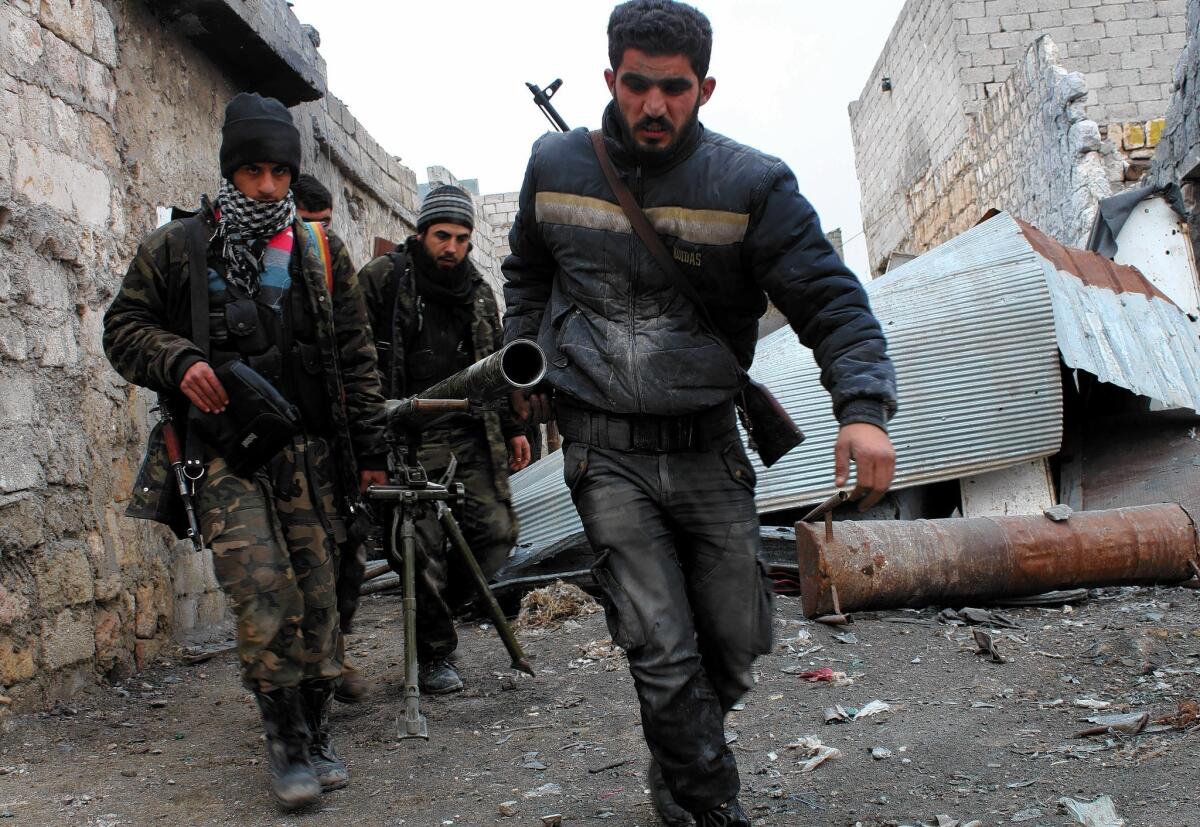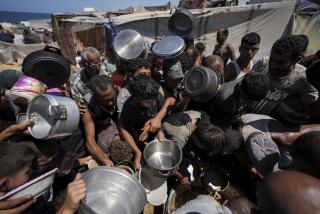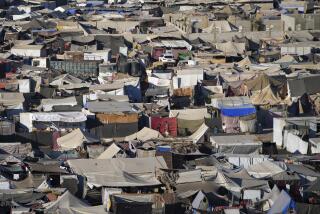Impasse imperils Syria aid deal reached at Geneva peace talks

GENEVA — A deal hammered out to aid trapped residents of the war-battered Syrian city of Homs appeared threatened Monday, as rebels demanded a cease-fire and relief supplies before anyone was allowed to evacuate.
The plan to facilitate the safe exit of residents stranded in the rebel-held Old City of Homs had been hailed as the first accord reached in peace talks that began here last week. United Nations officials voiced hope that trapped residents could begin leaving by Monday and that aid convoys would soon enter the neighborhood.
The deal even generated optimism that it could lead to broader relief for tens of thousands of people in besieged communities across Syria, including many in the largely Palestinian district of Yarmouk, on the southern outskirts of Damascus.
But a rebel alliance in Homs issued a series of demands that upped the ante, including a call for a 10-day cease-fire, delivery of 100 tons of food and medical supplies to opposition-held zones in Homs, and a “humanitarian corridor” that would allow the residents to evacuate to another, largely rebel-controlled district miles away.
The rebels said they would provide the U.N. with a list of people who wished to leave the besieged areas 48 hours in advance, suggesting that fighters wanted by the government would not be included. The rebels also sought guarantees that no one evacuated would be arrested.
There was no immediate response from the government, which had said that it was ready to implement the earlier, less-sweeping agreement, assuming opposition snipers did not open fire.
The hurdles evident in trying help a targeted population in one city highlighted the vast challenges facing the efforts to confront the humanitarian crisis unfolding throughout Syria.
About 250,000 people lacking food and other basic supplies are marooned in besieged areas of the country. They are cut off by one or both sides in the conflict. Each side has sought to use the plight of trapped residents to score public relations points.
Every siege has a character of its own, complicating any efforts to arrange for temporary cease-fires, the delivery of aid or the evacuation of noncombatants.
In Homs, about 1,500 civilians are said to be stuck amid the ruins of the rebel-held core of the Old City, once the throbbing heart of Syria’s third-largest city. More than two years of shelling and gunfire have laid waste to the area, which is now encircled by government troops.
A holdout force of rebels wields control deep in the warren of streets and alleys that crisscross the Old City. The remaining residents face, in effect, a double siege. Each side blames the other for forcing civilians to remain inside the sniper-infested perimeters. No one can leave without risk unless a guarantee of safe passage is given.
A similar fate is shared by a much larger population — perhaps 18,000 people — trapped in the Yarmouk district.
Yarmouk, founded in the 1950s as a camp for Palestinian refugees, long ago evolved into a bustling and dynamic mini-city that, before the Syrian war, was home to more than 200,000 Palestinians and Syrians. But in late 2012, the district became engulfed in Syria’s spreading conflict, resulting in a mass exodus.
Those who remain face dire shortages of essential supplies and cannot leave without fear of being killed.
The conflict in Yarmouk is unique in that its armed antagonists are rival Palestinian factions, some allied with the government of President Bashar Assad and others with the rebels. “We are fighting our brothers inside,” one pro-government militiaman lamented to a reporter last year.
In recent weeks, pro-opposition activists have alleged that dozens of people have died in Yarmouk from malnutrition and related illnesses. Disturbing images of what appear to be emaciated children and the withered corpses of the elderly have circulated on the Internet, though their authenticity cannot be verified. Aid officials have not confirmed any deaths related to hunger, but they have not discounted them.
“The reports we have of widespread malnutrition and children with rickets and anemia certainly give credence” to accounts of people succumbing to hunger-related ailments, Chris Gunness, spokesman for the United Nations Relief and Works Agency, which aids displaced Palestinians throughout the region, said in an email response to a Times query.
Yarmouk has been the subject of repeated mediation attempts involving representatives of the Palestinian Authority. As in other besieged districts, efforts to demilitarize the district and facilitate the flow of aid have floundered amid mutual suspicions and enmities.
Rebels holed up in Yarmouk have used civilians as “human shields” and a “humanitarian show,” charged Jumah Abdullah, an official with the Popular Front for the Liberation of Palestine-General Command, a pro-Assad faction in Yarmouk.
Antigovernment militants in Yarmouk view official cease-fire and reconciliation efforts as schemes to force capitulation. One activist, reached by telephone, said food and other supplies could be delivered regularly but that pro-Assad factions were insisting on doing it their own way in a bid to gain strategic advantage.
“They can bring in food — not in convoys and not from anyplace, but from a place where we can deliver it by hand,” said the activist, who used the nickname Abu Ahmad Hawwari out of safety concerns. “But there are people who do not want it done this way.”
As the impasse continues, aid groups say the desperation in Yarmouk and other besieged communities becomes more urgent with each day.
On Monday, the U.N. said it had been unable to deliver supplies — including powdered milk for infants, polio vaccines and basic foodstuffs — to Yarmouk for five days.
“We need safe, substantial and permanent access to Yarmouk and other civilian areas in Syria and [to] the civilians who are trapped and besieged.... All noncombatants must be allowed free and safe passage,” said Gunness of the U.N. relief agency. “The Syrian government and the armed groups must respect their obligations under international law.”
Times staff writer McDonnell reported from Geneva and special correspondents Bulos and Sandels from Beirut. Special correspondent Maher Abukhater in Ramallah, West Bank, contributed to this report.
More to Read
Sign up for Essential California
The most important California stories and recommendations in your inbox every morning.
You may occasionally receive promotional content from the Los Angeles Times.











